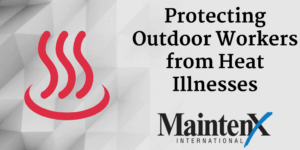
Every year, thousands of workers—especially those involved in the agriculture, landscaping, construction, and utilities fields—spend long, difficult days working in the hot sun.
Heat and sun exposure allow for many dangers: sunburn, dehydration, heat cramps, heat exhaustion, and heat stroke, just to name a few. Sadly, many of these workers become ill or lose their lives to heat exposure. Below are some ways to make sure your outdoor workforce is healthy, happy, and productive throughout the hot summer months.
Know the Risks
Outdoor workers are exposed to two main types of heat-related dangers:
Internal body heat from hard physical labor:
- Physical exertion
- Use of bulky or non-breathable clothing
- Carrying heavy equipment in the sun
Environmental heat arising from working conditions:
- High temperature
- High humidity
- Radiant heat sources
- Contact with hot objects
- Direct sun exposure with no shade
- Limited air movement
Warning Signs
Unfortunately, heat stroke victims often don’t recognize their own symptoms. That’s why to stay safe, workers need to be trained to detect symptoms in themselves and others and find medical help immediately.
Some common symptoms of heat stroke include:
- dry, hot skin (due to failure to sweat)
- profuse sweating
- very high body temperature
- hallucinations
- confusion
- seizures
- complete or partial loss of consciousness
Signs of heat exhaustion include:
- heavy sweating
- weakness
- dizziness
- thirst
- nausea
- headache
- vomiting
- diarrhea
- muscle cramps
- elevated body temperature
Heat exhaustion can quickly progress to heat stroke.
Stay Safe
Follow these steps to stay safe in the hot sun:
- Take breaks
- Rest in the shade when possible
- Eat during lunch or other breaks
- Stay hydrated: Drink plenty of cool water in hot weather conditions.
By training employees on the early signs of heat exhaustion, taking the proper precautions, and employing tips like the ones listed above, your outdoor workforce can reduce the risk of heat-related dangers.

